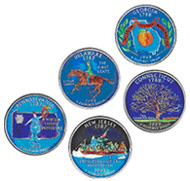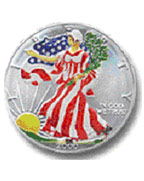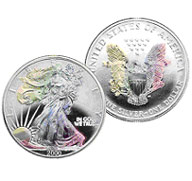|
Colorized Coins
Many businesses purchase genuine United
States coins and then use a variety of methods to "colorize"
the coins. The most common colorization techniques involve
painting an enamel finish on the coin or applying a
holographic image to the coin. Below are some examples of
colorized U.S. coins.



Not colorized by the United States Mint
FAQs
Does the United States Mint produce or sell
colorized coins?
No. The United States Mint has never produced or sold
colorized coins.
Does a business need permission from the U.S. Government to
colorize U.S. coins?
Businesses do not need the U.S. Government's permission to
colorize genuine United States coins unless the U.S.
Government owns copyright in the coin design in question.
Thus, consumers should not assume that the U.S. Government
has approved or sponsored the
colorized coins. Of course,
businesses are expected to ensure that they do not violate
U.S. trademark laws, false and deceptive advertising laws,
and third party rights.
Are colorized coins considered to be a good numismatic
investment?
The United States Mint does not comment on coin-grading
issues or on a colorized coin's current or future value as a
collectible item. If you like a colorized coin because of
the way it looks, then you may want to add it to your
collection. However, if you are primarily concerned about
the long-term investment value of a colorized coin, you
should contact a reputable coin dealer or coin grading
service before you purchase the coin.
Is a "bimetallic" coin the same as a
colorized coin?
No. As the name implies, a bimetallic coin is manufactured
using two separate components of different metals. In modern
bimetallic coins, the center component is usually made from
one metal, while the outer component consists of a totally
different metal. In the past, the United States Mint
produced a bimetallic coin -- the 2000 Library of Congress
Commemorative Bimetallic Ten Dollar Coin. This commemorative
coin was manufactured using both .9995 platinum and .9167
gold.
I've seen coins advertised featuring a holographic or
colorized image of prominent public figures. Are these
United States Mint products?
No. While the underlying coin itself may be a genuine United
States Mint coin, the United States Mint has never produced
a coin featuring holographic or colorized images. The
advertisements you have seen are from businesses that
purchase genuine United States Mint coins and alter them
with holographic or colorized images of their choice.
What is the United States Mint's position on the practice of
superimposing images of athletes or other prominent public
figures on genuine U.S. coins?
The United States Mint does not encourage or support
products that alter the fundamental images on its coins. A
superimposed design is entirely different than the coin's
original image and almost obliterates the coin's organic
design. Altering United States Mint coins this way may
heighten the concerns of people who regard the images and
designs on our Nation's coinage as sacrosanct. Indeed,
Congress itself mandates by statute the themes, images, and
inscriptions that appear on a particular coin. In most
cases, businesses are using American Eagle silver bullion
coins that Congress directed the United States Mint to
produce with the requirement that the coin "have a design .
. . symbolic of Liberty on the obverse side."
|